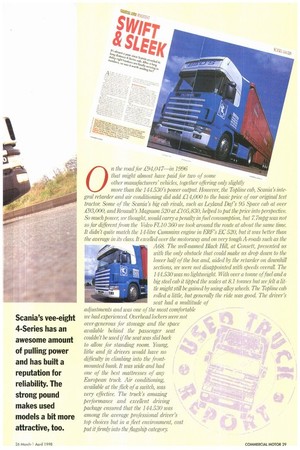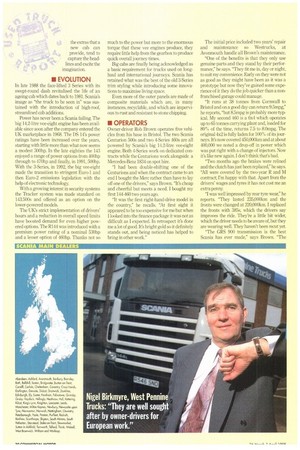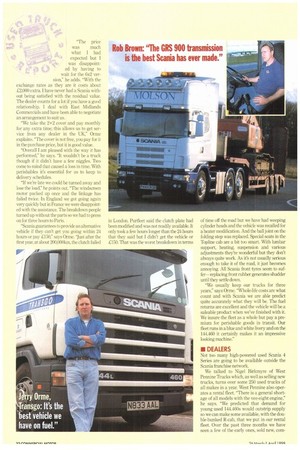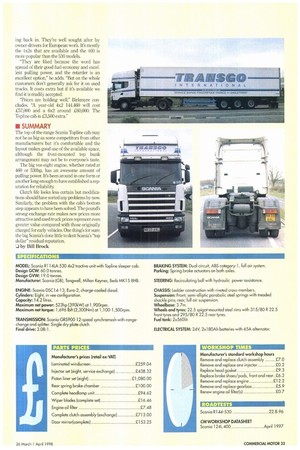"'STOP
Page 30

Page 31

Page 32

Page 33

Page 34

Page 35

If you've noticed an error in this article please click here to report it so we can fix it.
OLLAR
Scania's vee-eight 4-Series has an awesome amount of pulling power and has built a reputation for reliability. The strong pound makes used models a bit more attractive, too.
• Separation from the Saab car and aircraft divisions three years ago doesn't seem to have been detrimental to Scania's truckbuilding operation. Last year the company sold 26,756 trucks in western Europe and maintained its share above 15% in the heavy truck market while increasing sales in the developing central and eastern European markets by 80%.
The new 4 Series range must take the credit for a major part of the company's continuing success.
It's only two years since Scania made the range available in right-hand drive for the UK. While Continental operators were buying them 12 months ahead of us, the UK continued with the earlier range and some operators' expectations needed to be subdued with enticing prices.
Although not particularly relevant to dayto-day domestic operation, the models with the biggest and most powerful engines, with all of II.
On the road for .194,047—in 1996 that might almost have paid for two of some other manufacturers' vehicles, together offering only slightly more than the 144.530's power output. However, the Top/inc cab, Scania's integral retarder and air conditioning did add £14,000 to the basic price of our original test tractor. Some of the Scania's big cab rivals, such as Leyland Dors 95 Space cab at over 193,000, and Renault's Magnum 520 at .C105,830, helped to put the price into perspective. So much power, we thought, would carry a penalty in fuel consumption, but 7 7n2pg was not so far different from the Volvo FL) 0 360 we took around the route at about the same time. It didn't quite match the 14-litre Cummins engine in ERF's EC 520, but it was better than the overage in its class. It excelled over the motorway and on very tough A-roads such as the A68. The well-named Black Hilt at Consett, Presented us with the only obstacle that could make us drop down to the lower half of the box and, aided by the retarder on downhill sections, we were not disappointed with speeds overall. The 144530 was no lightweight. With over a tonne of fuel and a big steel cab it liPPed the scales at 8.1 tonnes but we felt a little might still be gained by using alloy wheels. The Top/inc cab rolled a little, but generally the ride was good. The driver's seat had a multitude of
adjustments and was one of the most comfortable we had experienced. Overhead lockers were not over-generous for stowage and the space available behind the passenger seat couldn't be used if the seat was slid back to allow for standing room. Young, lithe and fit drivers would have no difficulty in climbing into the frontmounted bunk. It was wide and had one of the best mattresses of any European truck. Air conditioning, available at the flick of a switch, was very effective The truck's amazing performance and excellent driving package ensured that the 144.530 was among the average professional driver's top choices but in a fleet environment, cost put it firmly into the flagship category.
the extras that a new cab can provide, tend to capture the headlines and excite the imagination.
• EVOLUTION
In late 1988 the face-lifted 3 Series with its swept-round dash revitalised the life of an ageing cab which dates back to 1981. Scania's image as "the truck to be seen in" was sustained with the introduction of high-roof, streamlined cab additions.
Power has never been a Scania failing. The big 14.2-litre we-eight engine has been available since soon after the company entered the UK marketplace in 1968. The DS 14's power ratings have been increased over the years, starting with little more than what now seems a modest 300hp. In the late eighties the 143 enjoyed a range of power options from 400hp through to 470hp and finally, in 1991, 500hp. With the 3-Series, in 1992, the big vee-eight made the transition to stringent Euro-1 and then Euro-2 emissions legislation with the help of electronic technology.
With a growing interest in security systems the Tracker system was made standard on 143.500s and offered as an option on the lower-powered models.
The UK's strict implementation of drivers' hours and a reduction in overall speed limits have boosted demand for even higher powered options. The R144 was introduced with a premium power rating of a nominal 530hp and a lesser option of 460hp. Thanks not so much to the power but more to the enormous torque that these vee engines produce, they require little help from the gearbox to produce quick overall journey times.
Big cabs are finally being acknowledged as a basic requirement for trucks used on longhaul and international journeys. Scania has retained what was the best of the old 3-Series trim styling while introducing some innovations to maximise living space.
Even more of the outer panels are made of composite materials which are, in many instances, recyclable, and which are impervious to rust and resistant to stone chipping.
• OPERATORS
Owner-driver Rob Brown operates five vehicles from his base in Bristol. The two Scania Centurion 500s and two 4-Series 460s are all powered by Scania's big 14.2-litre vee-eight engine. Both 4-Series work on dedicated contracts while the Centurions work alongside a Mercedes-Benz 1834 on spot hire.
"I had been double-shifting one of the Centurions and when the contract came to an end 1 bought the Merc rather than have to lay off one of the drivers,' says Brown. "It's cheap and cheerful but meets a need. I bought my first 144-460 two years ago.
"It was the first right-hand-drive model in the country," he recalls. "At first sight it appeared to be too expensive for me but when [looked into the finance package it was not as difficult as I expected. In retrospect it done me a lot of good. Ifs bright gold so it definitely stands out, and being noticed has helped to bring in other work." The initial price included two years' repair and maintenance so Westrucks, at Avonmouth handle all Brown's maintenance.
"One of the benefits is that they only use genuine parts and they stand by their performance," he says. "They fit me in, day or night, to suit my convenience. Early on they were not as good as they might have been as it was a prototype but now they've gained some experience of it they do the job quicker than a nonfranchised garage could manage.
"It runs at 38 tonnes from Cornwall to Bristol and on a good day can return 9.5rnpg," he reports, "but 8.5mpg is probably more typical. My second 460 is a 6x4 which operates up to 65 tonnes carrying plant and, loaded for 80% of the time, returns 7.5 to 8.0mpg. The original 4x2 is fully laden for 100% of its journeys. It's now covered 450,000km and at about 400,000 we noted a drop-off in power which was put right with a change of injectors. Now it's like new again. I don't think that's bad.
"Two months ago the brakes were relined and the clutch has just been replaced," he says. "All were covered by the two-year R and M contract; I'm happy with that. Apart from the drivers' wages and tyres it has not cost me an extra penny.
"I was well impressed by rear tyre wear," he reports. "They lasted 235,000km and the fronts were changed at 220,000km. I replaced the fronts with 385s, which the drivers say impmves the ride. They're, a little bit wider, which the driver needs to be aware of, but they are wearing well. They haven't been recut yet.
"The GRS 900 transmission is the best Scania has ever made," says Brown. "The
extra gears make the ratios closer together and the half-gear change down from top is all that's ever needed on the motorway. A retarder is specified on the 6x4 and that is brilliant.
"Electrics haven't been a big problem but the heater blower unit was replaced three or four times before they got it right and the headlights misted up until they put a vent hole in them," he adds. "I'm a great fan of the cab— I use it overnight only two or three times a month but I like the space. The front-mounted bunk is no problem and it's so wide. You can't sit up to read so I only use it when I want logo to sleep. If we're double shifting it's quite good because you get right out of the way. It cost £76,000 when it was new; exchange rates have reduced that to £71,000 which hasn't done much for the residual value. I was tempted to sell now but I will keep it another year. Imported LID models are still about £15,000 cheaper.
"I have made a couple of claims in the last year so my insurance premiums have gone up considerably," he adds, "Covering plant is more expensive than general haulage so I pay about 115,500 for the five vehicles. Overall I'm generally pleased with the trucks' reliability and performance, I think it's true that you get what you pay for, and although I have paid a bit extra the engine never missed a beat and it's got the job done."
Bird's Groupage Services is an international operation serving the whole Europe with depots in Germany, Ireland and London. The company's HQ is at Oldbury in the West Midlands.
Director Andrew Levett is the third generation to work in the business, which operates 96 vehicles. These include six Mercedes-Benz 1857 Actros tractive units, with another 10 on order, to satisfy a specific contract but Scanias form the lion's share of the fleet.
"We have 20 144-530s and 10 144-460s," says Levett. "They're very good for our job, both in running time and fuel consumption. They're all 4x2 units running with triaxle trailers which gives us a payload of 22 to 23 tonnes. The 530s average 7.8mpg and the 460s do much the same but are used over different routes.
"Some are double-shifted and those cover up to 130,000km a year," he says, but with just the one driver they average about 80,000km. Depending on the mileage we may keep them for four or five years. They're put on lighter duties after the first two and some we will change after three years.
"The whole fleet runs on Pirelli tyres which perform well for us," he adds. "We use 315/80s on the drive axle, which last about 220,000km, and we expect to get 200,000 from the fronts. Brakes are not a problem and are magic with retarders fitted. The oldest are two years old now and still have 14mm of lining left on them—and you just can't fault the we-eight engine.
"The 12-speed gearbox is a great improvement over the old 10-speed transmission." he says. "We've tried all the automatic boxes but they just don't compete with this manual box. We specify the Topline cab which stands up very well. The fold-down step wasn't right until they modified the ball joint but the cab
"The ride in the 4-Series is a vast improvement and driver comfort is 100% better," says Levett. "The 4 Series is also better on fuel. Scania prices are generally too expensive in the UK but we have been satisfied with residuals. They're a lot cheaper in Germany. Parts are pricey but they are worth it...they last well.
"Scania's Lifeline recovery service has room for improvement," he says. "When we've used it abroad they can make a simple job a lot harder. Being a large company our credit rating is good but I could see that an owner-operator or small firm might experience some difficulty in that area. We are very much hands-on when it comes to servicing but Westrucks does some for us. We hardly touch the we-eight engine—we have done 700,000 to 800,000km without laying a spanner on them. There's more sound insulation fitted on the current models but you can still get to everything."
Transgo International was established six years ago at Ashby de la Zouch, Leicestershire to manage an international refrigerated groupage and domestic distribution operation. Its eight tractive units all run with refrigerated trailers collecting fresh produce, mostly from France.
Managing director Jerry Orme says: "We run Scanias and a couple of Renault Magnum 520s. Our first 4-Series 144-460 with a Topline cab doesn't really suit our type of operation. We bought it in July 1996 and the 4x2 unit was the only one available at the time but we did have a 6x2 on contract for a while which has just gone back. Ours has covered 400,000km in less than two years, running between Paris and the Midlands. Fully freighted we get 9.0 to 10.0mpg. It's the best vehicle we have on fuel; we're pleased if the Magnums return 7.0tripg.
"I drive myself," says Orme, "so I know how the trucks perform. From Paris with the 460 you can get into top, select cruise control, and never touch the gears until arriving at Calais. "The price
was much what I had expected but I was disappointed by having to wait for the 6x2 version," he adds. With the exchange rates as they are it costs about 2,000 extra. I have never had a Scania without being satisfied with the residual value. The dealer counts for a lot if you have a good relationship. I deal with East Midlands Commercials and have been able to negotiate an arrangement to suit us.
"We take the 2+2 cover and pay monthly for any extra time; this allows us to get service from any dealer in the UK," Orme explains. "The cover is not free, you pay for it in the purchase price, but it is good value.
"Overall I am pleased with the way it has performed," he says. "It wouldn't be a truck though if it didn't have a few niggles. Two come to mind that caused a loss in time. With perishables it's essential for us to keep to delivery schedules.
"If we're late we could be turned away and lose the load," he points out. "The windscreen motor packed up once and the linkage has failed twice. In England we got going again very quickly but in France we were disappointed with the assistance. The breakdown people turned up without the parts so we had to press on for three hours to Paris.
"Scania guarantees to provide an alternative vehicle if they can't get you going within 24 hours or pay £150," says Orme. "Just after the first year, at about 200,000km, the clutch failed in London. Purfleet said the clutch plate had been modified and was not readily available. It only took a few hours longer than the 24 hours that they said but I didn't get the vehicle or £150. That was the worst breakdown in terms of time off the road but we have had weeping cylinder heads and the vehicle was recalled for a heater modification. And the ball joint on the folding step was replaced. Special seats in the Topline cab are a bit too smart. With lumbar support, heating, suspension and various adjustments they're wonderful but they don't always quite work. As it's not usually serious enough to take it of the road, it just becomes annoying. All Scania front tyres seem to suffer—replacing front rubber generates shudder until they settle down.
"We usually keep our trucks for three years," says Orme. "Whole-life costs are what count and with Scania we are able predict quite accurately what they will be. The fuel returns are excellent and the vehicle will be a saleable product when we've finished with it. We insure the fleet as a whole but pay a premium for perishable goods in transit. Our fleet runs in a blue and white livery and on the 144.460 it certainly makes it an impressive looking machine."
• DEALERS
Not too many high-powered used Scania 4 Series are going to be available outside the Scania franchise network.
We talked to Nigel Birkmyre of West Pennine Trucks which, as well as selling new trucks, turns over some 250 used trucks of all makes in a year. West Pennine also operates a rental fleet. "There is a general shortage of all models with the wee-eight engine." he says. "We predicted that demand for young used 144.460s would outstrip supply so we can make some available, with the double-bunked R-cab, that we put in our rental fleet. Over the past three months we have seen a few of the early ones, sold new, corn ing back in. They're well sought after by owner-drivers for European work. It's mostly the 4x2s that are available and the 460 is more popular than the 530 models.
They are liked because the word has spread of their good fuel economy and excellent pulling power, and the retarder is an excellent option," he adds. "But on the whole customers don't generally ask for it on used trucks. It costs extra but if it's available we find it is readily accepted.
"Prices are holding well," Birkrnyre concludes. "A year-old 4x2 144.460 will cost £57,000 and a 6x2 around £60,000. The Topline cab is £3,500 extra."
• SUMMARY
The top-of-the-range Scania Topline cab may not be as big as some competitors from other manufacturers but it's comfortable and the layout makes good use of the available space, although the front-mounted top bunk arrangement may not be to everyone's taste.
The big vee-eight engine, whether rated at 460 or 530hp, has an awesome amount of pulling power. It's been around in one form or another long enough to have established a reputation for reliability.
Clutch life looks less certain but modifications should have sorted any problems by now. Similarly, the problem with the cab's bottom step appears to have been solved. The pound's strong exchange rate makes new prices more attractive and used truck prices represent even greater value compared with those originally charged for early vehicles. One thing's for sure: the big Scania's done little to dent Scania's "top dollar" residual reputation.
by Bill Brack
SCANIA MAIN DEALERS
Aberdeen, Ashford, Avonmouth, Banbury, Barnsley, Bath, Mishit Boston, Bridgwater, Burtion.on-Trent, Cardiff, CarlIsle, CihnItenharn, Coventry, Cross Hands, Darlington, Dees1de, DIdost, Droierrich, Dumfries, Edinburgh, Ely, Exeter, Foreham, Feliestowe, Grimsby, Graby, Haydock. HellingJy, Heathrow, Hull, Kettering, Kiloot, King's Lynn, Knighton, Lancaster, Leeds, Manchester, Mbon Keynes. Newbury, Newcastle upon Tyne, Normonton, Norwich, Nottingham, Oswestry, Peterborough, Poole, Preston, Purl'leet, Rednuth, Renfrew, Scunthorpe, Skn, South Minns, South Petherlon, Slanstead, Stoke-on-Trent, Stawmariet, Sullon Ashfield, Farnsworth, rdbud. Thirslc Walsall, West Bromwich, Witham and Wodcsop.
MODEL: Scania RI 14LA 530 4x2 tractive unit with Topline sleeper cab. Design GCW: 60.0 tomes.
Design GVW: 19.0 tonnes.
Manufacturer: Scania (GB), Tongwell, Milton Keynes, Beds MK15 8HB.
ENGINE: Scania DSC14-13, Euro-2, charge-cooled diesel. Cylinders: Eight, in vee configuration. Capacity: 14.2 litres.
Maximum net power: 523hp (390kW) at 1,900rpm. Maximum net torque: 1,696 lbft (2,300Nrn) at 1,100-1,500rpm.
TRANSMISSION: Scania GRS900 12-speed synchromesh with rangechange and splitter. Single dry plate clutch. Final drive: 3.08:1. BRAKING SYSTEM: Dual-circuit, ABS category-1, full air system. Parking: Spring brake actuators on both axles.
STEERING: Recirculating ball with hydraulic power assistance.
CHASSIS: Ladder construction with riveted cross-members. Suspension: Front, semi-elliptic parabolic steel springs with treaded shackle pins; rear, full air suspension.
Wheelbase: 3.7m.
Wheels and tyres: 22.5 spigot-mounted steel rims with 315/80 R 22.5 front tyres and 295/80 R 22.5 rear tyres.
Fuel tank: 2x5601it.
ELECTRICAL SYSTEM: 24V, 2x180Ah batteries with 65A a(ternator.
PARTS PRICES
Manufacturer's prices (retail ex-VAT)
Laminated windscreen £259.04 Injector set (eight, service exchange) 2438.32 Piston liner set (eight) 21,080.00 Rear spring brake chamber 2100.00 Complete headlamp unit £94.62 Wiper blades (complete set) 216.46 Engine oil filter 27.48 Complete clutch assembly (exchange) £713.00 Door mirror(complete) £153.25
WORKSHOP TIMES
Manufacturer's standard workshop hours
Remove and replace clutch assembly £7.0 Remove and replace one injector 20.2 Replace head gasket £9.3 Replace brake shoes/pads, front and rear £6.2 Remove and replace engine £12.2 Remove and replace gearbox £5.9 Renew engine oil filter(s) £0.7
ROADTESTS
Scania R144-530 22.8.96
CM WORKSHOP DATASHEET Scania 124L.400 April 1997




































































































